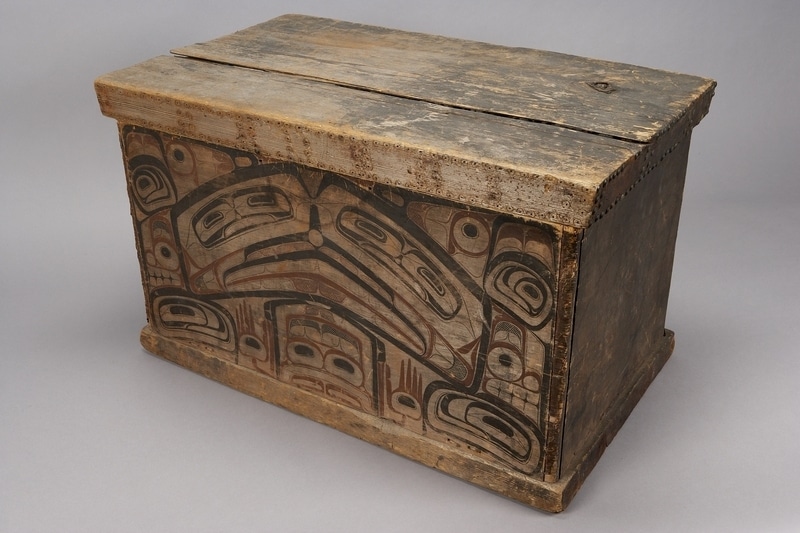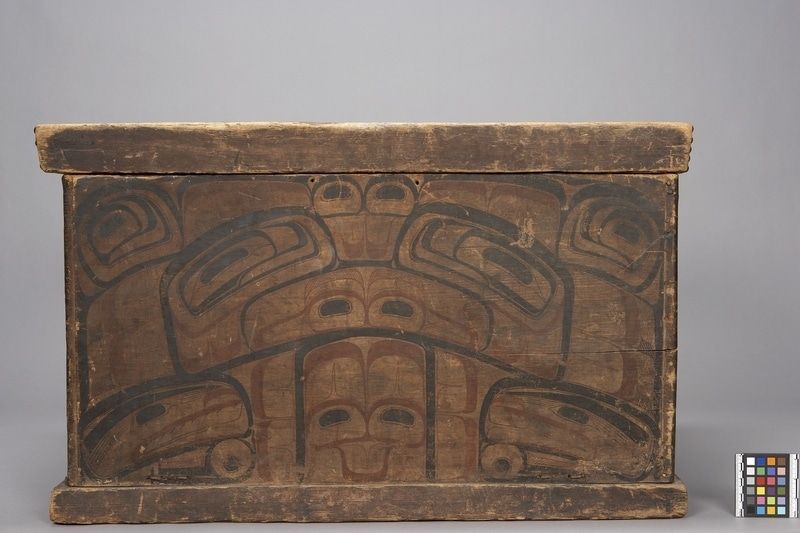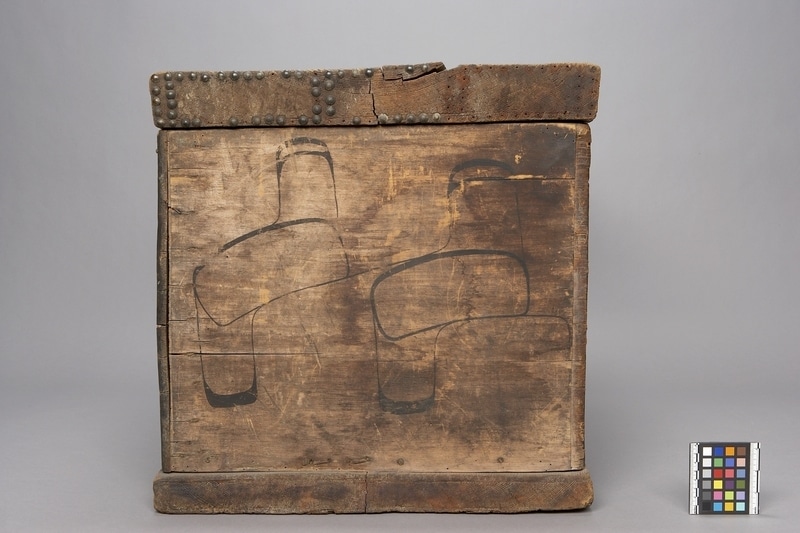Bentwood Chest Item Number: A8211 a-b from the MOA: University of British Columbia




Description
Rectangular bentwood box (part a) with lid (part b). The front and back are painted red and black in different designs. The front and back have complex designs. The sides have the same motif of vertical sets of ovoids and u-forms. Designs painted in black and red with stylized forms. The lid has decorative brass studs on three edges; the studs on the front are all gone, except one.
History Of Use
Kerfed boxes were used in a variety of ways. Audrey Hawthorn noted that they were watertight and: "used as vessels for storing water or fish oil, for cooking with water and hot stones, and for storage of foodstuffs and household gear... There were also boxes of ceremonial importance, finely carved and beautifully painted with family crests, which were used for the storage of the most valuable treasures of the family and were prized gifts in potlatch giving (1967:325)."
Cultural Context
ceremonial; storage; domestic
Specific Techniques
Bentwood, or kerfed-corner, containers are constructed by a process unique to the Northwest Coast Aboriginal peoples. The carver begins with a single straight-grained plank of red cedar, or sometimes yellow cedar, spruce, or yew. The surface of the plank is finished with chisels, adzes, and knives; in earlier times, it was smoothed further with sandstone or dried sharkskin. Then three parallel kerfs, or grooves, are carved out at measured points across the width of the board, at right angles to the long edge. The kerfs, which will become three corners of the box, allow the board to be steamed until the wood fibres are softened, and then carefully bent to form a box with symmetrical sides. The final corner, as well as a fitted base, are joined and fastened with pegs (through drilled holes) or laced with spruce root or twisted cedar withes (branches). Storage boxes also have fitted lids of cedar, hollowed from the inside. Finally, painted compositions may be applied to the completed box and shallow carving added to bring the forms into relief. A well-made bentwood box is watertight. Historically, most boxes were used to store preserved foods and material goods; plain cooking boxes could be used to steam or boil food by adding water and heated stones.
Narrative
This origin or maker of this bentwood box is unknown. It was previously identified as a Haida box, however according to documentation, the box was last owned by a Cowichan family so it is listed as such. The box is also said to be painted in a Heiltsuk style. The designs are similar to those on a Tlingit box in the Rasmussen Collection of the Portland Art Museum, which are described by Hillary Stewart as having "double-eye motifs in a large head filling half the space. Human hands below have salmon-trout heads on the palms (1979:87)."
Item History
- Made in Bella Bella, British Columbia, Canada and 'Qvuqvai, British Columbia, Canada during 1880
- Collected in Duncan, British Columbia, Canada between 1950 and 1962
- Owned by Chief Charlie Solwheymault
- Owned by Edith Bevan Cross before July 30, 1962
- Received from Edith Bevan Cross (Seller) and H. R. MacMillan (Funding source) on July 30, 1962
What
- Name
- Bentwood Chest
- Identification Number
- A8211 a-b
- Type of Item
- chest
- Material
- brass metal and red cedar wood
- Manufacturing Technique
- kerfed, steamed, painted, pegged, nailed, cut and bent
- Part A
- height 45.5 cm, width 78.5 cm, depth 49.0 cm
- Part B
- height 6.0 cm, width 83.5 cm, depth 51.0 cm
- Overall
- height 51.0 cm, width 83.5 cm, depth 51.0 cm
Who
- Culture
- Coast Salish: Quwutsun'
- Previous Owner
- Chief Charlie Solwheymault and Edith Bevan Cross
- Received from
- Edith Bevan Cross (Seller) and H. R. MacMillan (Funding source)
Where
- Holding Institution
- MOA: University of British Columbia
- Made in
- Bella Bella, British Columbia, Canada and 'Qvuqvai, British Columbia, Canada
- Collected in
- Duncan, British Columbia, Canada
When
- Creation Date
- during 1880
- Collection Date
- between 1950 and 1962
- Ownership Date
- before July 30, 1962
- Acquisition Date
- on July 30, 1962
Other
- Condition
- fair
- Accession Number
- 0081/0132 a-b